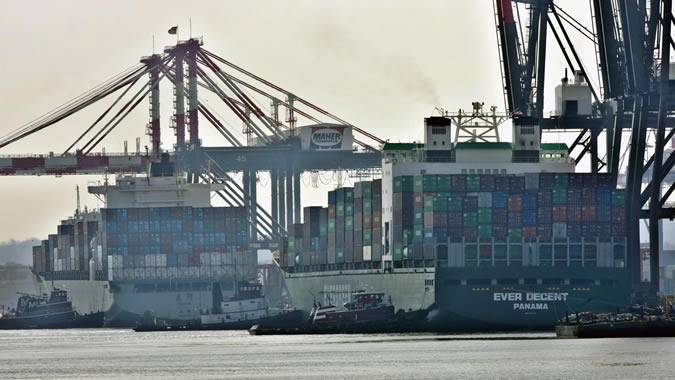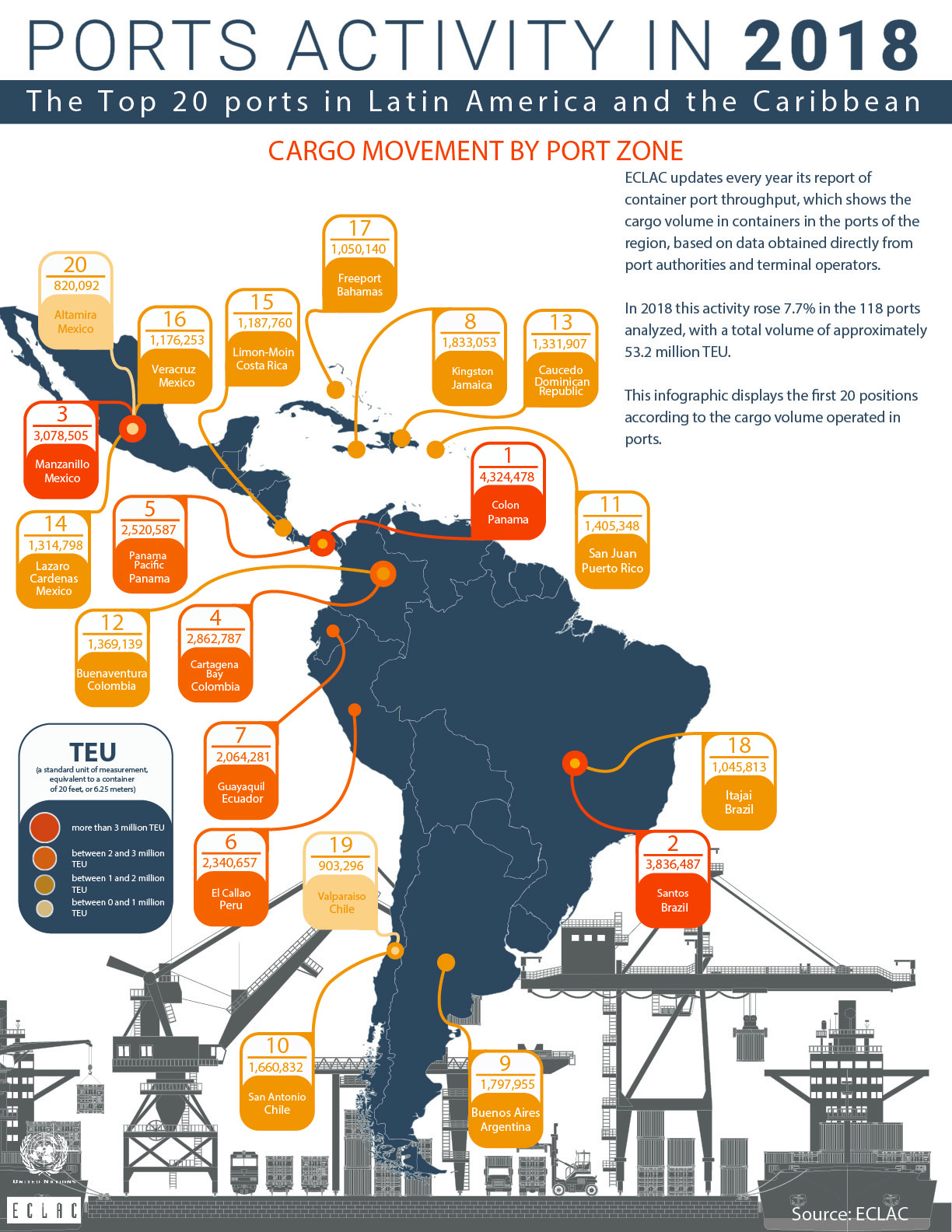Cargo Throughput in Ports of Latin America and the Caribbean Rose 7.7% in 2018
Work area(s)
Topic(s)
ECLAC released a new edition of its annual report on ports today.

Container throughput in ports of Latin America and the Caribbean increased by 7.7% in 2018 in comparison with the previous year, according to data released today by ECLAC. This analysis is based on the performance of a sampling of 31 countries and 118 ports and port areas in the region.
According to the annual report unveiled by the United Nations organization – which was called “port ranking” in prior years – the data largely maintained the heterogeneity seen in throughput behavior in previous periods, both in reference to ports and countries. Of the total sample, 66 ports and port areas saw their figures improve versus 2017.
The total volume of activity in 2018 exceeded 53.2 million TEU[1], which represents 7.1% of global throughput, marking a slight increase in the rate versus the previous year (when it amounted to 6.6% of global throughput), according to the Economic Commission for Latin America and the Caribbean (ECLAC).
The ten countries contributing the most to the total volume of cargo handled represented 84.1% of regional movement. These are (from highest to lowest based on the quantity of TEU mobilized): Brazil, Mexico, Panama, Colombia, Chile, Peru, Argentina, Ecuador, the Dominican Republic and Jamaica.
According to the data of the sampling compiled by ECLAC, in 2018 the East Coast of South America (ECSA) recorded a 12% increase in the activity of ports and port areas, measured in terms of volume. Meanwhile, the West Coast of South America (WCSA) continued with a slight upward trend, growing 7% in 2018, compared with the 6% seen between 2016 and 2017. The Caribbean showed 12% growth in total throughput, while Central America (without including Mexico) had more subtle growth of 7% only on the West Coast, since the East Coast essentially maintained the same activity levels as in 2017. The Gulf of Mexico area grew 8% versus 2017, and Pacific Mexico 11%. Panama, meanwhile, experienced growth on its Caribbean coast (11%) with regard to the country’s total throughput, while its Pacific coast registered a decline of -16%.
On this occasion, ECLAC’s annual port report includes some format modifications that are aimed at including other analyses of the data, which will also be incorporated in the future into the Maritime and Logistics Profile[2] managed by the institution.
These novelties include an examination of the tonnes mobilized by port and port area in 2018. Of the 20 ports and port areas in the sampling, only those in Brazil show individual tonnage exceeding 100 million, while the top twenty ports include terminals in Argentina, Brazil, Colombia, Mexico and Panama.
Another example is an analysis of the relative importance of container transhipment[3] in relation to total throughput in a country. In the first ten countries, the total of transhipments represents nearly 30% of the entire throughput of the 31 countries and 118 ports and port areas under consideration. Caribbean ports represent 22.3%, while the importance of the East Coast of South America is striking in 2018.
For comparative purposes, ECLAC also includes port throughput on a global level in 2018, which was led by Shanghai (China), with 42,010,000 TEU mobilized. Here one can appreciate the truly massive difference of nearly 38 million TEU seen versus the region’s first position, held by the port of Colón (MIT, Evergreen, Panama Port), which notched just over 4,324,000 TEU last year. The ten biggest ports on a global level represent 32.2% of global throughput in 2018, while those of Latin America and the Caribbean represent just 3.5%.
More information:
- Report on container throughput in Latin America and the Caribbean 2018 (briefing note with tables).
- Infographics: Ports Activity in 2018. The Top 20 Ports in Latin America and the Caribbean.
- ECLAC’s Maritime and Logistics Profile.
[1] The acronym for Twenty-foot Equivalent Unit. This refers to the standard measurement of a metallic box of standardized size that can be easily transferred between different modes of transport, such as ships, trains and trucks.
[2] The web page of ECLAC’s Maritime and Logistics Profile is undergoing a process of transition and reconstruction. Therefore, the additional data will be added later.
[3] Transhipment is the operation of shifting cargo from one ship to another so it may be sent to its final destination in another port. This operation is normally carried out at an intermediate port that acts as a transhipment port.
Related content

Ports Activity in 2018. The Top 20 ports in Latin America and the Caribbean
ECLAC updates every year its report of container port throughput, which shows the cargo volume in containers in the ports of the region, based on data obtained directly from port authorities and…

Port activity report of Latin America and the Caribbean 2018
New edition analyses 31 countries and 118 ports and port zones of the region
Related link(s)
Country(ies)
- Latin America and the Caribbean
Contact
Public Information Unit
- prensa@cepal.org
- (56 2) 2210 2040